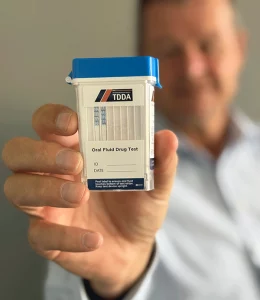Substance use among workers is holding steady, but their drug selection continues to shift in a dangerous direction, according to the second quarter 2025 workplace report from The Drug Detection Agency (TDDA) New Zealand’s largest workplace drug testing provider.

Tramadol Tester
The TDDA report provides an analysis of drug usage trends, evolving risks, and aggregated national testing results. Tests were taken from more than 27 clinic locations and 60 mobile clinics throughout New Zealand.
Opioids now account for 18.9 percent of all positive results, up 1.5 percent from the first quarter 2025. Tramadol alone made up 3.1 percent of detections. This development echoes growing global concern of prescription opioid misuse, particularly its dependence risks and links to risks of impairment.
“Our Q2 findings make it very clear that the types of substances people are taking changes rapidly. The rise in opioid detections, including tramadol positives, is a clear sign that employers must stay vigilant. Amphetamine and cannabis activity also remains a serious concern, they are dominant choice in several regions,” says chief executive Glenn Dobson.
“Employers need to take a hard look at their policies and training. In high-risk environments, drugs and alcohol have catastrophic consequences for worker safety and business continuity.
“Businesses need to rapidly address any gaps in awareness on prescription opioids such as tramadol, especially in Bay of Plenty and Auckland East where we’re seeing sharp upticks.” says Dobson.
Amphetamine-type substances (ATS) made up 31.0 percent of positives. While slightly down from Q1 (31.6 percent), this drug type is still elevated against late 2024 levels (30 percent), signalling persistent methamphetamine activity in New Zealand’s workplaces.
Cannabis (THC) detections have eased slightly, yet in regions like Gisborne and Tasman, THC remains the dominant substance detected, surpassing 75 percent of all positive screens.
TDDA workplace testing showed the most prevalent substances detected across all positive tests in New Zealand
- Cannabis was present in 63.3 percent of positive tests, down 5.4 percent from 68.7 percent in Q1 2025
- Amphetamine-type substances: 31 percent, down 0.6 percent
- Opiates and opioids (including ‘oxy’ and tramadol): 18.9 percent, up 4.6 percent (Tramadol was tested for the first time and accounted for 3.1 percent of opiate and opioid testing this quarter)
- Benzodiazepines: 4.7 percent, down 0.2 percent
- Cocaine: unchanged at 1.7 percent
Region-specific spikes
- Gisborne: THC represented 91.7 percent of local positives, an increase of 27 percent from Q1; ATS also rose from 11.8 percent to 33.3 percent in the same quarter.
- Tasman: THC increased from 58.3 percent in Q1 to 77.8 percent of local positives.
- Bay of Plenty: Opioid detections jumped from 12.8 percent in Q1 to 25.4 percent of local positives
- Auckland East: Opioid detections jumped from 10.2 percent in Q1 to 25.9 percent of local positives
- The Lakes: ATS surged more than 22 percent, from 37 percent in Q1 to 59.6 percent of local positives.
TDDA recommends that companies apply policies consistently, maintain fit for purpose testing programmes, provide education, and focus on understanding trends and region-specific issues to keep workplaces safe.
“Businesses cannot afford to be complacent. The drugs people are taking change rapidly. The shift to opiates and amphetamines need careful management because the data show substance misuse is evolving.” says Dobson.
“Drug use adapts to trends like cost, cartel activity and easy availability, and so must workplace policies. Businesses must invest in comprehensive drug education, fit-for-purpose testing programmes, and region-specific management to stay ahead of issues. Proactive investment today can safeguard both workers and operations tomorrow.”
Methodology
Testing data from 1 April 2025 and 30 June 2025 is aggregated and anonymised from 27 clinic and 60 mobile clinic operations throughout New Zealand. Data from preemployment, post incident, regular and random testing has been combined. Testing methods included urine and oral fluid screening. Data is reported into the TDDA Imperans system, anonymised, and represents a snapshot of drug trends across New Zealand workplaces and industries. TDDA conducts and tracks over 250,000 tests every year.
TDDA drug tests screen for amphetamines; benzodiazepines; cocaine; methamphetamine; opiates and opioids; cannabis; tramadol; fentanyl; and synthetic drugs like synthetic cannabis.
For the purposes of this report, the term “positive result” refers to non-negative initial screening results. This approach was adopted to provide a comprehensive view of potential drug presence in the workforce, acknowledging that not all non-negative samples proceed to confirmatory testing due to operational constraints such as employee resignation, withdrawal of consent, or logistical limitations in sample viability.
While confirmatory testing offers definitive identification, initial non-negative results are used given their relevance to immediate workplace safety considerations and policy triggers.
Poly-drug use, where multiple drugs are present in the same test, is common.
The Drug Detection Agency
TDDA) is a leader in workplace substance testing with more than 300 staff, 90 mobile health clinics, 65 locations throughout Australasia, and processes more than 250,000 tests annually. TDDA holds ISO17025 accreditation for workplace substance testing in both Australia and New Zealand. https://tdda.com/.
